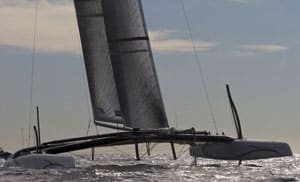(Ed’s Note: David Pedrick has been principal designer in eight America’s Cup campaigns, beginning with the 1974 winner Courageous while at Sparkman & Stephens and including the 1987 winner Stars & Stripes. He helped create the America’s Cup Class rule in 1988 and was engaged by America’s Cup Management in 2009 as Technical Director of the new AC33 Class developed for this America’s Cup as a multi-challenger event. David is observing and reporting for Sailing World from Valencia.)
The America’s Cup has been called The Grandest Prize. This 33rd edition of the famed event is sure to be the most spectacular match of sailing machines ever staged. Other than a basic waterline length limit of 90 feet under the Cup’s Deed of Gift, there has been no limit on the competing teams’ imagination about performance, design and engineering-nor, evidently, on expense.
To borrow an expression, those who value laws, sausages and the America’s Cup should not watch them being made. So, for the next few days, forget about the ugly arguing to get here. The end result is a feast for the eyes. These are, by far, the fastest sailing craft for closed-course racing that have ever been built. Until the past year or so, the world had never seen anything like these giant, spindly, powerful, elegant, amazingly fast sailboats, and still hasn’t seen the only two of them in existence go up against each other.
|| |—| | Gilles Martin-Raget | |**BMW Oracle Racing’s USA, complete with its wing sail. **| The understandably protective teams have issued limited PR photos, and unauthorized photography has been hard to shoot. So, live streaming aerial video of Larry Ellison’s USA and Ernesto Bertarelli’s Alinghi 5 on Monday will put online sailing fans in privileged seats.
While watching on computer screens, try to absorb the scale of these craft. At roughly 100-feet long by 90-feet wide, their hulls overflow a baseball diamond. If you were to stand at the crest of the Newport Bridge, at 215 feet, you’d be looking up at the top of USA’s huge wing sail, at 223 ft. In its nominal homeport of San Francisco, USA would not be able to sail under the Golden Gate Bridge, where the clearance is 220 feet.
In fact, this is the biggest wing ever made-about double the span of one wing on a Boeing 747. Alinghi 5’s more familiar mast and soft sails spread similar area on a somewhat shorter spar-on the order of 200 feet above water-although the power-to-weight ratio on what may be a lighter platform should be comparable to that of USA. Sail sheeting loads reach up to 20 tons-greater than the barely immersed weight that they’re propelling at 25 to 35 knots or more.
As challenger, BMW Oracle Racing blinked first, and early, in launching its initial solution to ultimate speed under sail in mid-2008. (Keep in mind the 90-foot WL limit, and windward-leeward sailing.) Its design and research team decided on three hulls, although only a single, slender leeward hull sees the water most of the time. The center hull serves practical needs as a structural girder to support the enormous fore-and-aft loads of the sail plan, as well a crew pod for sail handling and a place to anchor the jib lead. A substantial bowsprit extends the jib and reacher forward of the hull. Design development remained dynamic, with changes to the bows of the trimaran’s outboard hulls, soft sail development, and then the wing.

George Johns/Alinghi| |**The truss system underneath Alinghi 5 is key to keeping the spindly structure together and tension in the enormous rig. **| Alinghi had a dual design program, for a new monohull class in the multi-challenger match that it wanted, as well as a multihull to answer the Deed of Gift challenge by Mr. Ellison (via the GGYC). In April 2009, the multihull program was confirmed. The Alinghi design team’s research led it to a sleek and efficient catamaran that was launched by helicopter for sea trials on Lake Geneva, where SNG is located; and then by helicopter again, over the Alps to Genoa for testing and further development. Alinghi 5 uses a minimal truss system of compression members and stays below them to transmit the rig’s huge loads.
With the clock ticking its final hours to Race 1, at 10 a.m. Monday in Valencia, Spain (4 a.m. US EST), both of these teams have earned unqualified congratulations for their extraordinary innovation, bold design, unprecedented engineering and enormous effort in producing the two most amazing racing yachts ever seen.









